As we make our way into this new century, the traditional methods used for repairing post-collision brake problems have, for the most part, become obsolete. This is apparent not only from the manufacturer’s service literature, but also from experience while attempting to isolate the cause of contemporary problems, like when a faulty “ABS” (anti-lock brake system) light won’t respond to older repair techniques.
And ABS problems just scratch the surface. As brakes become more technologically advanced and become available with numerous options, the decision to repair collision-damaged brakes in-house becomes very important. Also worth noting is that experts say brake problems are now more plentiful, since drivers seem to be less aware of the maintenance required to keep them in good shape.
Shops are learning, however, that while more brake jobs may be coming, the complexities in repairing them can be enough of a headache to force an owner to send the brake repair elsewhere. Still others want to keep the repairs in-house to have more control over the total job. This is what makes the brake question – to repair or not to repair – so difficult.
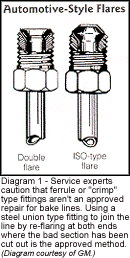
The Answer Men
I spoke with several brake hotline specialists for this article. Matt Gorsky, a veteran tech-line specialist for NAPA Brakes, and his colleagues answer between 10,000 and 15,000 calls a month just on brakes alone. According to Gorsky, more than 20 percent of all calls fall into the ABS category.
Hotline specialists say the new brake service procedures are comparable to the launch of a new NASA project. Why? Because the intricate nature of the various systems makes it impossible to provide a procedure or group of procedures to emulate all possible scenarios. This is why brake hotlines are in such demand.
With regard to ABS, the specialists have helped techs from all kinds of shops bleed air-entrained systems without the use of special tools. But central processing units (CPUs) damaged during paint booth baking procedures are still a problem, according to Gorsky. These items must be removed before the chassis system is exposed to the high baking temperatures. ABS computers are sometimes left in place because of their location in the vehicle interior; some are located under the dashboard or in the trunk, making them difficult to remove. Expect a failure or brake system difficulties if the computer systems remain.
“A lot of the shops we deal with are intimidated by the newer systems,” says Gorsky. “Four-channel systems that use a lot of solenoids and valving seem to throw these folks. The basic principles, however, are the same. In many cases, troubleshooting still begins with the ordinary service brake system. The ABS with a code library as long as your grocery list are no more complex to service than many of the early two-channel types. We encourage lab scope usage to enable the technician to isolate problems in electronic components, such as wheel speed sensors.”
Wheel speed sensors can also create all kinds of brake confusion if components are bent by collision or other related damages. A lab scope analysis of such items can save hours on other troubleshooting. Why? Because a lab scope measures amplitude and duration of a signal and it’s a visual representation of a sensor signal, so it’s better than a digital volt ohm meter.
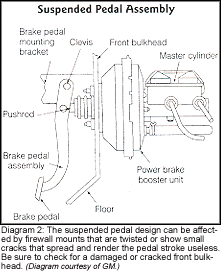
Parts and Proliferation
The hardware on even the regular systems has become a challenge, especially when shops don’t ordinarily offer services such as re-line and other mechanical side tasks. An example comes from a body shop in the St. Louis area that fought for more than a month with a front caliper replacement problem on a 1993 Pontiac Transport. The vehicle was damaged in a hard hit involving a panic stop. The left front caliper was damaged and a replacement was ordered from a reliable aftermarket source. The new caliper was physically identical except for minor casting differences on the face of the outside casting. This allowed for an easy installation and the correct bleed-out procedure for the ABS to be accomplished. All seemed well.
But when the custom wheel was installed, problems began. The wheel made physical contact with the caliper face and immediately locked up the assembly. A check with the jobber revealed the vehicle was indeed spec’d correctly and according to all of the catalog data.
Another attempt to obtain the correct part resulted in a second caliper that was too small for the vehicle but would, in fact, fit the anchor. A late-model mid-year caliper change was suspected, and the original jobber ordered this item as well as a late 1994 version just in case. The late 1993 version was identical to the caliper that made contact with the wheel, so it was sent back. The late 1994 version arrived at the end of the second fruitless week and was indeed identical to the original unit. A subsequent check with a dealer organization showed an error in their own catalog system, but the caliper that was to be installed on the Transport was a third version of the incorrect design, including an entirely different design of pads. The aftermarket late- 1994 caliper was finally used to restore the vehicle.
The bleed-out procedure went well, and the vehicle finally made it out the door. The collision work from start to finish took 16.7 hours. Not too bad. However, the restoration of the brake system involved about 60 hours of dead time and another 13 hours of actual procedure to clear the vehicle through the repair process. Who can possibly foresee such a problem?
This scenario isn’t an isolated incident, and brake systems seem to be a snake pit for collision shops. In fact, these types of problems have become more common in the last several years, according to many experts. The many options on brakes make for difficult parts acquisition problems, so the jury is still out on the profitability of brake repair, especially with high-tech items like ABS, coupled with traction control or other stability systems. The big benefit, however, seems to be the ability to maintain in-house liability on the repair.
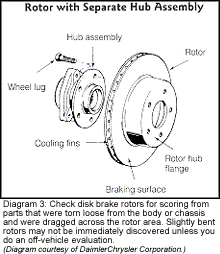
An Argument for Sending Out Brake Work
Who wins in the brake service game? A body shop that sends its brake work to a mechanical shop might come out ahead, depending on the mechanical shop’s reputation and abilities. For example, Kevin Smith – assistant body shop manager for Lou Fusz in Kirkwood, Mo. – says the mechanical shop that’s part of the dealership organization performs nearly all the brake work on the vehicles that go through the body shop.
According to Smith, the specifics of individual systems often call for special tools that many body shops don’t have. The complexity of later ABS isn’t the only reason behind this school of thought. “We simply don’t have the trained manpower to perform the extensive test drives and other related procedures that are required to wash out many of these problems,” Smith says. “Experts already in place within the dealership are the best bet.”
I also found that many brake specialty shops can better deal with the newest designs and experience more success. I spoke with a few of these specialists.
Chris Whitfielc, brake service specialist for Hampton Firestone, a St. Louis tire dealer heavy into brake repair, spoke about several collision shops serviced through his store. Most of the collision shop services related to ABS come in because of brake pulls that need to be removed following a crash. The SUVs offer a greater challenge — due to their off-road usage — since they often have damaged wheel and/or suspension parts that affect braking.
“I feel that we do so much brake work on an everyday basis that we can offer these shops a good service they can depend upon,” says Whitfielc.
The service menu for brake system repairs at this particular dealer includes off- and on-car rotor and drum machining (on-car machining is sometimes a must to eliminate vibration problems related to brake systems). Also on this menu are caliper rebuilding and brake application pressure testing, which are used to eliminate the possibility of an integral ABS dropping pressure to a wheel.
Nick Wiseman, a brake and alignment specialist, works at an independent service shop in Heyword, Wis. His shop often repairs brake as well as air bag problems on vehicles that come from body shops. Wiseman approaches each vehicle as a separate case.
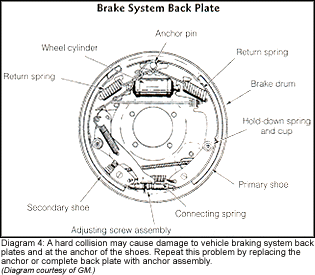
“The ABS are notably reliable,” he says. “Body shops keep looking for patterns, I think, and in my opinion, very few exist. Trucks that seem to always end up with a light stuck on after service or after body shop work is completed probably had a light on at least some of the time before the accident.”
Drivers pay little attention to the lights since many dealers and service shops tell them that lights that only come and go can be ignored. Wiseman goes over the basic brake system with his customers from top to bottom and only uses factory tools and procedures to attack an ABS malady.
“You can’t make a living by guesswork when dealing with late-model braking systems,” says Wiseman. “I see a trend in the making that has specialists going door-to-door, much like some of the ‘air bagger’ mobiles do now. These guys will be able to work out the brake bugs in body shops as well as in some dealerships. Look for this to happen in the next few years.”
Keeping It In House … Most of the Time
West End Auto Body, located in the St. Louis suburb of Wellston, does all of its own brake work with the exception of ABS. Owner Barnett DuBose says he’s sometimes frustrated by the complex brake systems that end up in his facility, but insists that a good brake repair job is a team effort and can be accomplished by a body shop.
“We fix most of the stuff and use good quality parts,” he says. “That’s the best insurance policy a body shop can have. If the jobber and manufacturer stand behind the parts, you have peace of mind.”
But when it comes to ABS, DuBose’s shop sends the harder jobs to the car dealers. “We haven’t had a bunch of good luck [on ABS] and are looking at alternatives,” he says “I’d like to see a mobile service to cover the brake and air bag systems.”
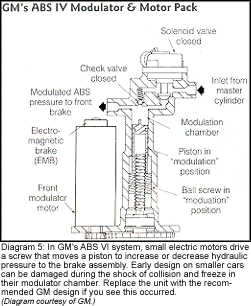
Juggling the Struggling
The majority of body shops I saw continue to struggle with the problem of high-tech brake repair. It seems the big city shops are better able to ship most of the problem vehicles to car dealers or other brake specialists, while many rural and large franchise shops do all the repairs in-house. They choose to buy the brake bleeders, scan tools, software and other items that make the difference in the end result.
But systems that make money for the well-equipped shop can be a nightmare for other dent and paint shops. Do more shops fix brakes or have the work done at another facility? I’d say it’s about 50/50, but in the future, it may be less as brakes become more high-tech and more jobs are sent to specialists.
A common thread that seems overlooked is the shop’s ability to call upon a technician hotline service, such as those mentioned earlier. In many cases, these people have the answers the body shop needs. In other situations, the shop, at the very least, will know where it stands with regard to the repair. Other avenues, such as building a relationship with a car dealer or brake shop, are also certainly worth considering.
In the long run, shops with the correct tools, the best training and those plugged into the better resources will be the best prepared to handle brake repairs in house. Those that aren’t as prepared should stick with what they know best – and leave brake work to the experts.
Writer Bob Leone, a retired shop owner and contributing editor to BodyShop Business, is ASE Three-Way Master Certified and is completing qualifications as a post-secondary automotive instructor in the vocational-school system in Missouri.
|
The Dirty Dozen
After polling collision shop techs about day-to-day operations, it was easy to find 12 common problems that occur in brake systems as a result of – or in conjunction with – a typical collision shop procedure. 1. Brake line problems – Many top shops are faced with crushed and/or damaged brake lines. The procedure for taking care of these problems involves a section replacement of the affected line, a splice using a union and flare or ISO fittings, or a complete end-to-end factory service replacement of brake lines. Service experts caution that ferrule or “crimp” type fittings aren’t an approved repair for braking systems. Using a steel union type fitting to join the line by re-flaring at both ends where the bad section has been cut out is the approved method. 2. Pedal support damage – Another common but often overlooked problem can be found in the pedal support and associated linkage mechanism. Notice that the suspended pedal design can be affected by firewall mounts that are twisted or show small cracks that spread and render the pedal stroke useless. 3. Internally damaged vacuum boosters – A hard stop may mean an operator has placed excessive force on the power brake booster. The type of damage includes bending the parts that may cause the control valve to move off-center and create a “hard pedal” condition. The remedy here is to replace the assembly and examine the master cylinder assembly for signs of damage. 4. Brake caliper problems – Shops that do any amount of brake work see problems associated with disc calipers. Aside from procuring the correct fit parts, other concerns should include chipped caliper pistons, stuck or jammed pistons, frozen pins or over-travel on assemblies that damage hardware or other related parts. Replace any suspect caliper with a rebuilt unit. It’s also a good idea to replace items in pairs so brake timing and balance remain. 5. Scored rotors or warping due to impact damage at the wheel – Check disc brake rotors for scoring from parts that were torn loose from the body or chassis and were dragged across the rotor area. Slightly bent rotors may not be immediately discovered unless you do an off-vehicle evaluation. This is ordinarily done when a wheel hub is replaced. 6. Bent eccentric in shoe-type brakes — A hard collision may cause damage to vehicle braking system back plates and at the anchor of the shoes themselves. This problem may mean one or both shoes will fail to release and vibrate on application. Repair this problem by replacing the anchor or complete back plate with anchor assembly. 7. ABS wheel sensor damage – These are damaged due to their location at the extreme ends of the axle spindles or at the outside of wheel hubs. Broken jumper wiring can’t be repaired in most cases, and the sensor should be replaced. Using an AC volt-meter, DVOM or sweeping the sensor with a lab scope will turn up a malfunction or other electrical problems invisible to the naked eye. Repair this problem by installing and then setting the gap on a new sensor. 8. Leaking accumulators – ABS that use high pressure accumulators in the ABS modulator system or for power assist are subject to cracks and internal damage from a hard hit. Follow manufacturer’s guidelines during testing and use the correct pressure gauge setting. If defective parts need to be replaced, replace and re-test to assure correct operation. 9. General Motors ABS VI problems – GM ABS VI is unique in its control modulator because a motor pack is used to drive ball screw valves that are as mechanical in nature as you can get in this hybrid, high-tech design. The early designs on smaller cars can be damaged during the shock of collision and freeze in their modulation chamber. Replace the unit with the latest recommended GM design if you see this has occurred. 10. Parking brakes – Hand-brakes located at the console or on the floorboard are subject to damage from occupant movement during the panic of an emergency or the collision itself. Check for bent handles, stripped ratchet teeth and twisted cable linkage. Crushed or twisted cables must be replaced and adjusted correctly to provide the repaired vehicle with a safe parking mechanism. Techs should also route all cables in the same manner as the original installation. This prevents rubbing, melting of the jacket against hot exhaust, rattles and other problems related to this mechanism. 11. Brake pedal switches – Cruise, torque converter release and other ABS-related switches that use the brake pedal should be thoroughly tested after a hard hit. These items can be damaged from shock, over-travel and interference with collision-damaged items within the vehicle interior during a crash. 12. Brake level indicators – Reed switches or other level switches normally found in the master cylinder reservoir are often damaged from shock during a collision. If the red light or level indicator won’t go off after the system has been bled and fluid has been replenished, replace the switch and/or lid assembly to correct the problem. |
|
What ABS Problem?
ABS problems occur when electrohydraulic control units sit around dormant while normal braking bypasses their function. Then, during an stop, fluid rushes into most areas that may have accumulated sludge and particulate matter. Most manufacturers would like to see fresh brake fluid in ABS-equipped vehicles on a regular maintenance schedule basis. Unfortunately this rarely happens, so the fluid and moisture absorbed over time create oxidation and sludge problems, which may lead to occurrences of sticking or damaged control valves after a hard stop. This situation is completely separate from the direct damage that’s a result of impact in a collision. You can expect to see crushed brake lines, damaged calipers and damaged mounting brackets. |













